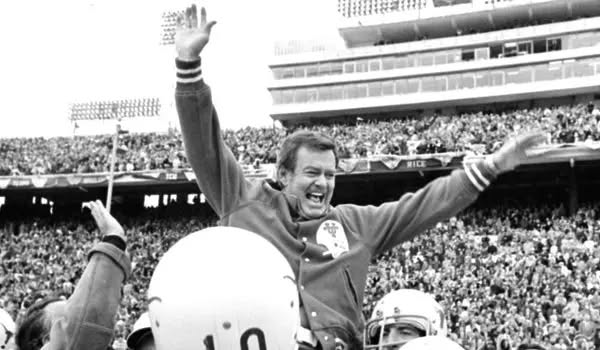Darrell Royal, who led the University of Texas Longhorns football program from 1957 to 1976, is etched into the annals of college football as one of the most influential and successful coaches in the history of the sport. Over the course of his 20-year tenure, Royal not only transformed Texas into a perennial powerhouse but also helped define the very essence of what it means to be a Longhorn. Known for his innovative approach, his unwavering discipline, and his deep commitment to integrity, Royal’s legacy goes far beyond wins and championships—it is interwoven with the very identity of Texas football.
Born on July 6, 1924, in Hollis, Oklahoma, Royal was a product of humble beginnings. He played quarterback at the University of Oklahoma under coach Bud Wilkinson and became known for his leadership and intelligence on the field. After serving in World War II and enjoying a brief career as an assistant coach, Royal took the reins at Mississippi State before accepting the Texas job in 1957 at just 32 years old. It was at Texas where he would leave a permanent mark, shaping the program into one of college football’s most revered.
When Royal arrived in Austin, the Longhorns were far from the juggernaut they would become. The team had suffered several down years and was in need of a spark. That spark came almost immediately. In his first season, Royal led Texas to a 6-4-1 record, a dramatic improvement that set the tone for things to come. Just two years later, in 1959, he had Texas ranked No. 4 in the final AP Poll with a 9-2 record. The climb had begun, and there was no looking back.
Royal’s coaching style was a blend of strategic brilliance and fundamental discipline. He believed in toughness, precision, and team unity. But perhaps his greatest strength was his ability to innovate. In the late 1960s, Royal, along with offensive coordinator Emory Bellard, introduced the wishbone formation—an offensive scheme that would revolutionize college football. The wishbone emphasized a powerful running game and misdirection, which confused defenses and maximized the talent of Texas’ deep backfield. Under this system, Texas found overwhelming success, and the rest of the country soon followed suit. The wishbone quickly spread across college football, becoming a staple of the era.
Texas’ dominance under Royal’s leadership was undeniable. He compiled a remarkable career record of 167 wins, 47 losses, and 5 ties, good for a .774 winning percentage. His teams won 11 Southwest Conference titles and claimed three national championships—in 1963, 1969, and 1970 (coaches’ poll). The 1963 team went undefeated and beat Navy in the Cotton Bowl to clinch the school’s first consensus national title. The 1969 squad, led by quarterback James Street and legendary running back Steve Worster, achieved similar glory, capping their perfect season with a win over Notre Dame in the Cotton Bowl. That title, shared with President Richard Nixon’s controversial midseason declaration of Texas as national champs, remains one of the most discussed in college football history.
Royal’s success was not just measured by trophies and accolades but also by the culture he created. He was known for his principled leadership and high expectations for his players on and off the field. He insisted on academic accountability, personal responsibility, and doing things “the right way.” He wasn’t a coach who tolerated shortcuts or tolerated excuses. He demanded excellence but treated his players like family. Many of his former athletes still refer to him as a father figure, someone who instilled values that extended far beyond football.
Royal’s commitment to equality and progressiveness also stood out in a time of great social change. While Texas was slower than many programs to integrate, Royal played a significant role in ensuring the transition was handled with dignity and fairness. He recruited and coached Julius Whittier, who became the first Black letterman in Texas football history in 1970. Royal helped lay the groundwork for a more inclusive program, and while he himself admitted the challenges of that era, he never shied away from the responsibility to lead with integrity.
Perhaps one of the most enduring aspects of Darrell Royal’s tenure was his ability to adapt without losing sight of the program’s core identity. Over 20 years, college football underwent massive changes—from television coverage and scholarship rules to recruiting battles and societal shifts. Through it all, Royal maintained a clear vision: discipline, teamwork, and pride in wearing the burnt orange. His teams weren’t always the flashiest, but they were among the most prepared, mentally tough, and physically relentless.
After retiring from coaching in 1976, Royal continued to serve the university in various administrative and advisory roles. He remained a revered figure in the Texas community and a beloved icon in Austin. In 1996, the university honored his immense contributions by renaming the stadium Darrell K Royal–Texas Memorial Stadium. It was a fitting tribute for a man whose name had become synonymous with Longhorn football. That stadium, with its imposing structure and sea of burnt orange, stands as a living monument to his legacy.
Royal’s impact extended beyond the field. He was an avid supporter of the arts, education, and public service. Along with his wife, Edith, he contributed to numerous causes and was deeply engaged in the Austin community. Even after stepping away from football, he remained a guiding force, mentoring young coaches and players, and offering his wisdom with characteristic humility.
His relationship with Texas fans was something rare and special. Royal was never just a coach—he was the embodiment of Longhorn pride. The chants of “Hook ‘em” echoed louder when Royal was on the sideline. His presence brought a sense of calm and confidence to the program, and his words carried weight not because they were loud or boastful, but because they were grounded in purpose and authenticity.
Darrell Royal passed away on November 7, 2012, at the age of 88. His death marked the end of an era, but his legacy lives on in the traditions, spirit, and pride of Texas football. Every fall Saturday in Austin, when the Longhorns take the field under the bright lights of the stadium that bears his name, his influence can still be felt. From the players who wear the uniform to the coaches who follow in his footsteps, Royal’s presence is as enduring as the burnt orange and white.
To many, Darrell Royal was more than just a coach—he was a teacher, a mentor, and a symbol of excellence. His ability to lead with vision, to win with class, and to elevate those around him set a standard that few have matched. In the ever-changing world of college athletics, where programs rise and fall with the tide of talent and fortune, Royal’s consistency and character remain benchmarks of what greatness looks like.
In the pantheon of college football legends, Darrell Royal stands tall. Not simply because of the trophies or the victories, but because of the way he went about achieving them. He built a legacy rooted in principle, and that legacy continues to inspire generation after generation of Longhorns. As long as Texas football exists, Darrell Royal’s spirit will echo through the locker rooms, the sidelines, and the hearts of every player who wears the Longhorns jersey with pride.



